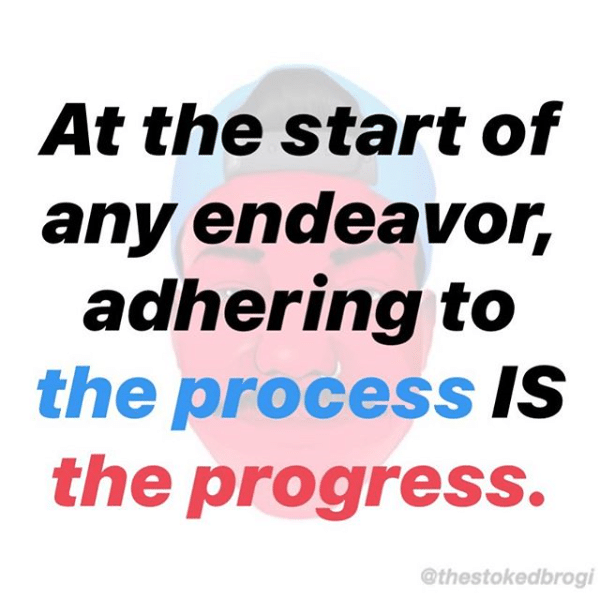A few weeks ago, I was approached by a client who seemed upset. Not knowing what was going on, I asked how she was doing. This client, who I’ll call Emma, was frustrated, upset, and feeling discouraged; she was in pain. You see, her main goal was to lose body fat; she was upset that her clothes didn’t fit the same anymore. Emma didn’t like how she felt.
Here she was, at the gym, working hard, and trying to get rid of the body fat for weeks and weeks with little progress to show for it.
Big effort, little progress. Lots of frustration. That lack of progress caused very real pain.
Seeing this frustration and pain as we spoke, I asked her if she wanted to meet and discuss an action plan to help her make progress. She agreed and we met the following week.

Emma Didn’t Fail, She Was Courageous
When we sat down to chat, after catching up on how her day was and how she was doing, I asked her to walk me through how things were going with fat loss: what she had tried, how she was feeling about change, and anything else.
Part of what Emma said to me was that in the past she had attempted to eliminate sugar completely from her diet; her friend, who had seen success with fat loss, had recommended this strategy. Hopeful, Emma gave it a shot, but after a few weeks of trying it, nothing happened. Nada. No change.
What happened? Well, eliminating sugar may been a good call for Emma’s friend, but that didn’t guarantee it was a good call for Emma. And, as she spoke, I realized something: Emma made it seem as though she had failed tons and tons of times with these diets; only, I saw things differently.
From my perspective, I saw someone that showed courage. Someone who was willing to try something new and experience failure. Someone who wanted to take a risk, to embrace the discomfort that accompanies change, and improve her life. That, dear reader, is amazing.
And luckily for Emma, there was hope. When it comes to fat loss there is no on size fits all approach. Many options, many behaviors or habits, can lead to fat loss. The key for her was discovering what worked, not for Emma’s friend, but for Emma.
Emma’s Initial Approach
Before we discuss Emma’s solution, how she is now kicking serious butt and taking action towards her goal, we have to discuss something else that got in her way: not trusting the process.
Emma had a tendency of going after big, lose body fat quick approaches, hoping that—with each one she tried—the progress she dreamed of would become reality.
So we spoke about this.
About trusting the process.
About making, not a change in diet, but in lifestyle.
About sticking with something long enough to see it work.
Because as my buddy Michael Bouranis said, “At the start of any endeavor, adhering to the process is the progress.”

Think about this: from research, we know that the majority of people who lose a ton of body fat gain it back over time. Why? Because quick magic-pill fixes don’t address the underlying system that caused the issue.
As Dan Heath says,
“Every system is perfectly designed to get the results it gets.”
Emma had a great system in place. Well, if her goal was not losing fat, that is.
What Emma needed was not a quick fix, but a better system. A lifestyle change, in other terms. And, to trust that system, that process, to take her towards her goal.
A Better System
When I spoke of the importance of lifestyle change to Emma—how it helps us maintain fat loss over the long haul—she agreed. It made sense to her, but she was at a loss. “Where do I start,” she asked.
“With a big ol’ brain dump,” I suggested.
I asked her to—without censoring, judging, or overthinking her thoughts—blurt out any behavior or idea, big or small, that would help her towards fat loss. With a little time, here’s what she said:
- eat veggies with breakfast;
- have skim milk with coffee instead of whole milk;
- eat out once per week instead of two;
- less snacking at work;
- eat lunch at 11am when truly hungry (she felt she had to wait until 12, which, led her to eat more because she was starving);
- less snacking on weekends; and
- eat more protein with dinner
Awesome! With a little time and a little brain dumping, we had a game plan. At first, she knew what she wanted but not how to get there. Now, she saw how to move towards her goal; she had hope.
Next, I asked her, “Out of these 7 ideas, which do you feel will have the most impact to you?” She said that numbers 1, 2, 3, and 4 from above would have a big impact. Cool.
I then asked, “If you had to pick 1 or 2 of those four, which do you feel you could easily get yourself to do?”
Almost immediately, Emma said numbers 1 and 2.
Heck yeah! Now we’re talking! (Well, Emma and I had been talking the whole time but you get what I mean.)
What started as frustration and pain had morphed into hope and enthusiasm.
But wait!
We’re at an important point: while having a list of things to do is great, it can be overwhelming. So, I suggested we start with one thing.
Yup, your eyes read that correctly—one thing.
It’s easy, so stinking easy, to overwhelm ourselves at this point. We want to do all of the things and stuff and whatnot at once, but, we start with one thing. Why? Because, we’re more likely to succeed when doing one thing at a time.
“Well, what happens after that is completed?” you might be thinking.
Simple: we do the next one thing.
Emma’s Progress
The following week, I touched base with Emma to see how she was doing with adding veggies to breakfast. She said, “It’s been good. I’ve been having veggies every morning now and don’t feel as hungry later in the morning, so I don’t feel the need to snack.” Woo! She was successful and felt good about it!
Now, was Emma able to instantly drop pounds of fat because of adding veggies to her breakfast? Nope. That’s okay. It wasn’t the point. Success leads to success; it creates momentum; momentum helps us make continued positive changes.
For Emma, that initial success will be the first of many. She trusted the process: she blurted out things she felt would help her with fat loss, picked ones that would be both impactful and easy to get herself to do, then started with one thing.
Emma’s next one thing is adding skim milk to coffee instead of whole milk. And after that? The next one thing.
Emma didn’t need another fad diet, or magic pill fix; she didn’t need to keep feeling frustrated and hopeless, knowing what she wanted but not how to get there.
She needed a better system—a lifestyle change to move her towards the fat loss goal. Now that she knows a way forward, a process to achieve the fat loss goal, she has hope. She has a sustainable plan to make her dream become her reality.
